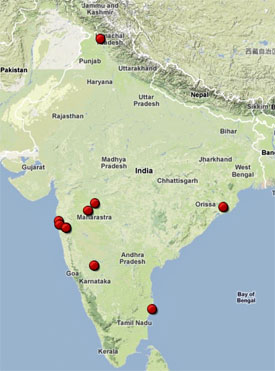World 🢖 Asia 🢖 India 🢖 Tamil Nadu
Hindu shrines 🢔 Religious architecture 🢔 Architectural wonders 🢔 Categories of wonders
Wonder
Pancha Rathas, Mahabalipuram
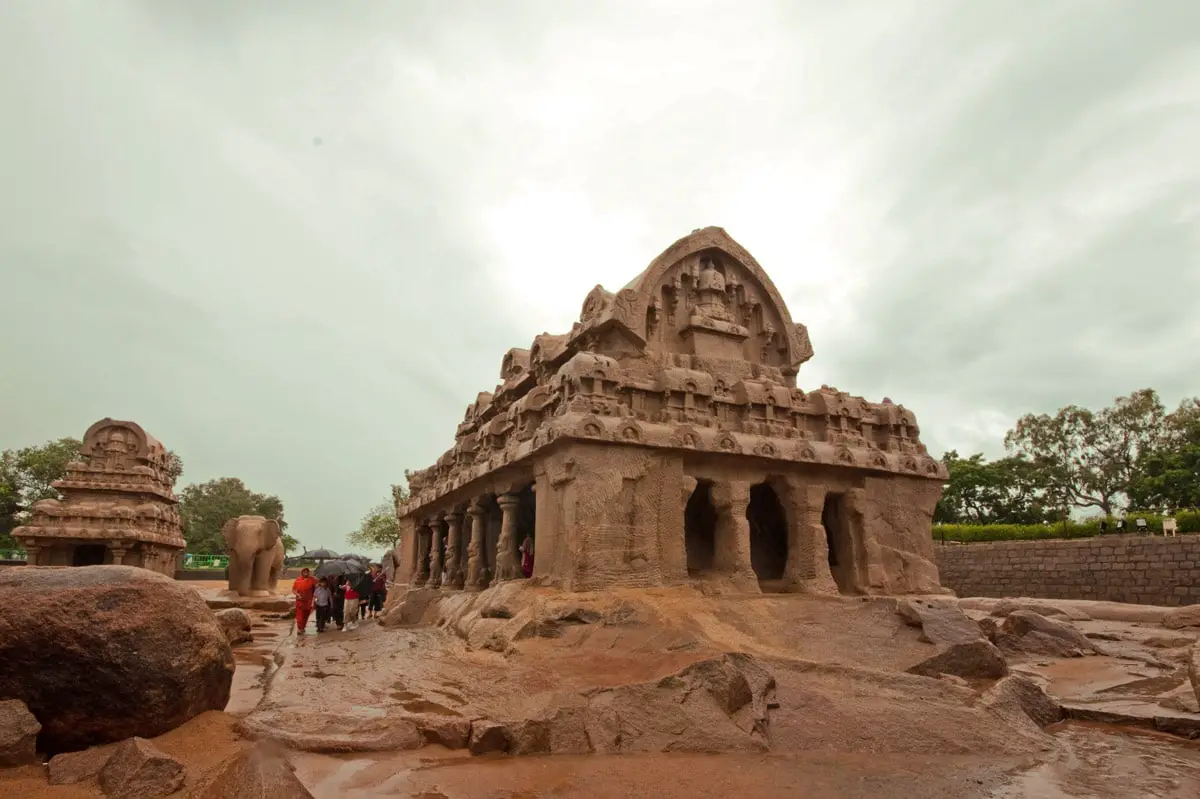
 In short
In short
Pancha Rathas are some of the most surprising structures not only in Mahabalipuram but in the whole Southern India. This group of ornate, monolithic structures was cut from a single stone in the late 7th century.
 52.5%
52.5%
GPS coordinates
Location, address
Age
Religion
UNESCO World Heritage status
Map of the site
If you see this after your page is loaded completely, leafletJS files are missing.
 In detail
In detail
Rare example of monolithic rock-cut buildings
It is not known what was the true purpose of the building of Pancha Rathas. But as the inscription in one of these amazing structures tells, this happened during the times of the great Tamil king Mamalla (Narasimhavarman I, ruled sometimes around 630 – 670 AD).
Rock-cut architecture is not that common in the world and most of it represents caves and passages cut in the rock. Pancha Rathas though belong to the very rare examples where whole buildings with ornate exterior and interior are cut from a live cliff.
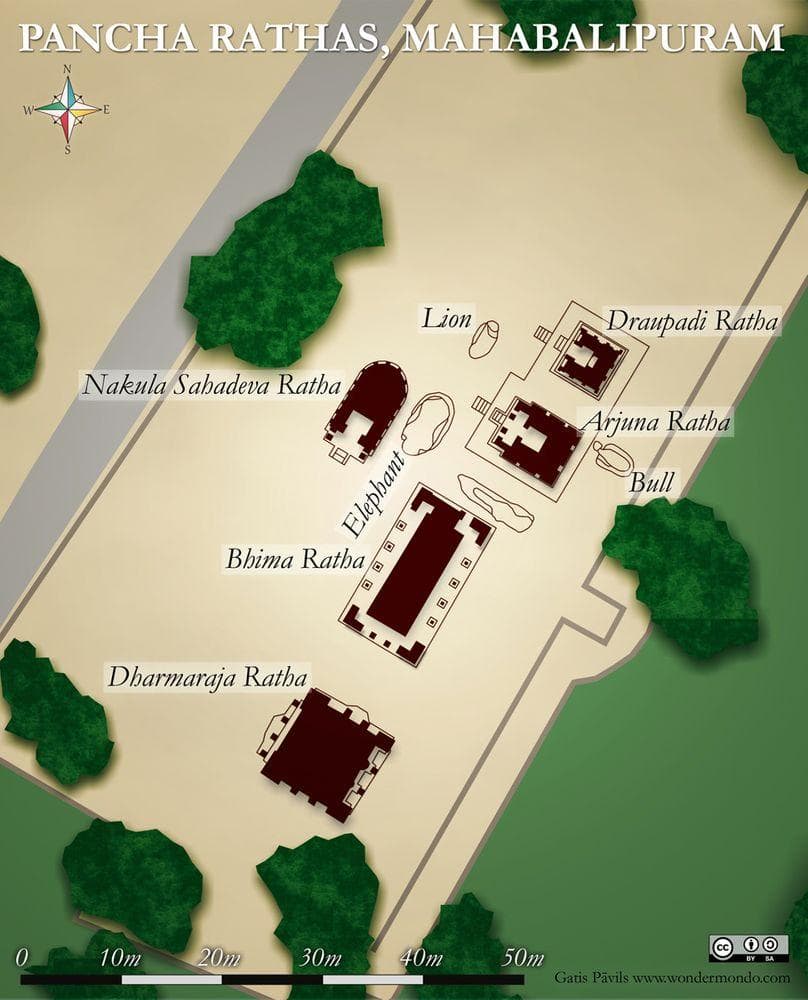
Sample collection of Dravidian architecture
The incredibly skilled Indian stonecutters here used a ridge of pink granite and, by removing the "spare" cliff, created a five structures – rathas – and three large monolithic sculptures among these structures.
Structures are named rathas (ritual chariots – temple carts) as somebody in the past thought that they resemble such carts. Pancha rathas in Hindi mean "five chariots". This term, of course, is not correct because these temples are not moveable. Four of these rathas though are arranged in a row – like a procession frozen in stone.
Art historicians speculate that these rathas were created as models of diverse typical South Indian temples. Their architecture most likely is much influenced by the architecture of wooden structures.
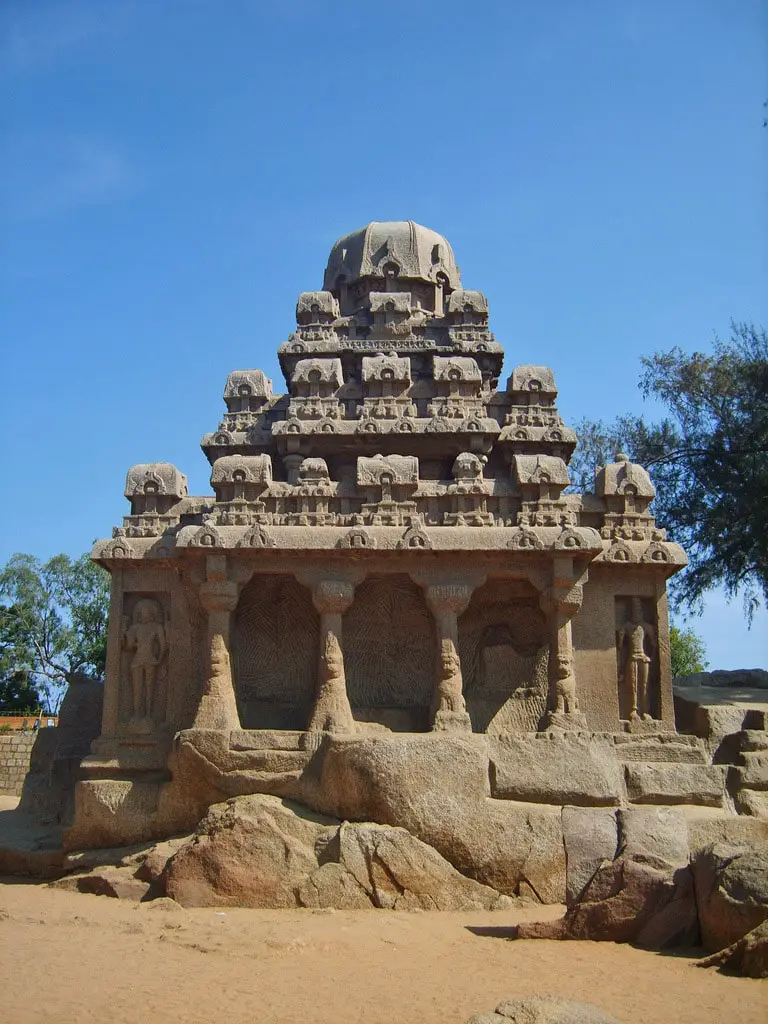
All five rathas have very diverse planning, architecture and ornamentation and in a way serve as textbook examples of South Indian temple architecture.
Four rathas have stepped pyramidal roofs.
Each ratha has got interior room – simple and narrow sanctuary (garbha-griha).
Five shrines and three sculptures
It is not known whether Pancha Rathas have ever been used as temples. Most likely they were not consecrated because their stupas are still attached to the bedrock. Many other details are not completed either.
Although the works were not completed, this has not harmed the structures in any way. The local granite has been very sturdy and has survived the test of time very well. It has resisted the constant salty winds from the nearby ocean, as well as a catastrophic tsunami in the 13th century. Tsunami in 2004 here was less pronounced.
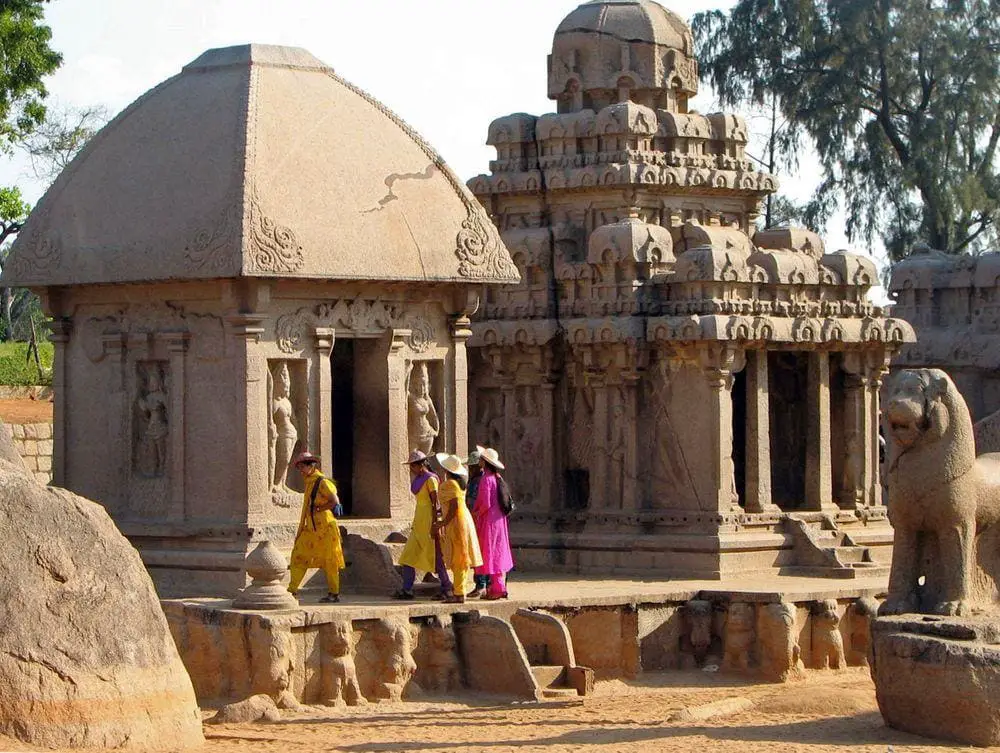
Rathas are named after Draupadi and the Pandava brothers – what is not quite correct as these shrines have nothing to do with these characters of Mahabharata. The five rathas are (from north to south):
- Draupadi Ratha
- Arjuna Ratha
- Nakula Sahadeva Ratha
- Bhima Ratha
- Dharmaraja Ratha
Among the rathas are three large sculptures:
- Lion
- Elephant
- Nandi bull
Description of rathas
Draupadi Ratha (Draupati Ratha)
The closest to the entrance gate is Draupadi Ratha – it is also the smallest one.
This shrine is shaped like a thatched hut, with a square roof. It and the nearby Arjuna Ratha are on a single platform – upa-pitham, which also is raised and adorned with figures of lions and elephants.
This shrine is devoted to goddess Durga and it shows in the amazing artwork. Possibly the best of them is a finely carved panel, which shows Durga on a lotus pedestal. Goddess is surrounded by other characters, including a man who is preparing to cut off his head as a sign of devotion.
Outside, above the entrance door, is carved a stylized sea monster. On the eastern wall, there is an interesting sculptural group – Durga standing on the head of Mahishasura – a killed demon.
Some sculptures have not been finished.
Arjuna Ratha
On the same platform is located the next ratha – Arjuna Ratha, which is devoted to Shiva.
This small structure is shaped like a small wooden shrine, once characteristic of Southern India. It is facing towards the east and has two stories, a small portico, and carved pillars.
Inside the shrine there are no adornments, but the exterior is very rich with interesting details.
The facade is adorned with magnificent sculptures, showing gods and humans. Noticeable is a pair of beautiful apsaras with lissom bodies.
Nakula Sahadeva Ratha
This shrine is devoted to Indra and is associated with elephants. This ratha is the only one which is not placed in a "procession", it stands aside. It is also the only one with the entrance facing south.
Ratha represents an apsidal vimana – horseshoe-shaped shrine, it is almost completed.
The roof of this shrine is shaped like the back of an elephant.
One wall of ratha is adorned with a relief sculpture of Ardhanariswara, columns and pillars are adorned with seated lions.
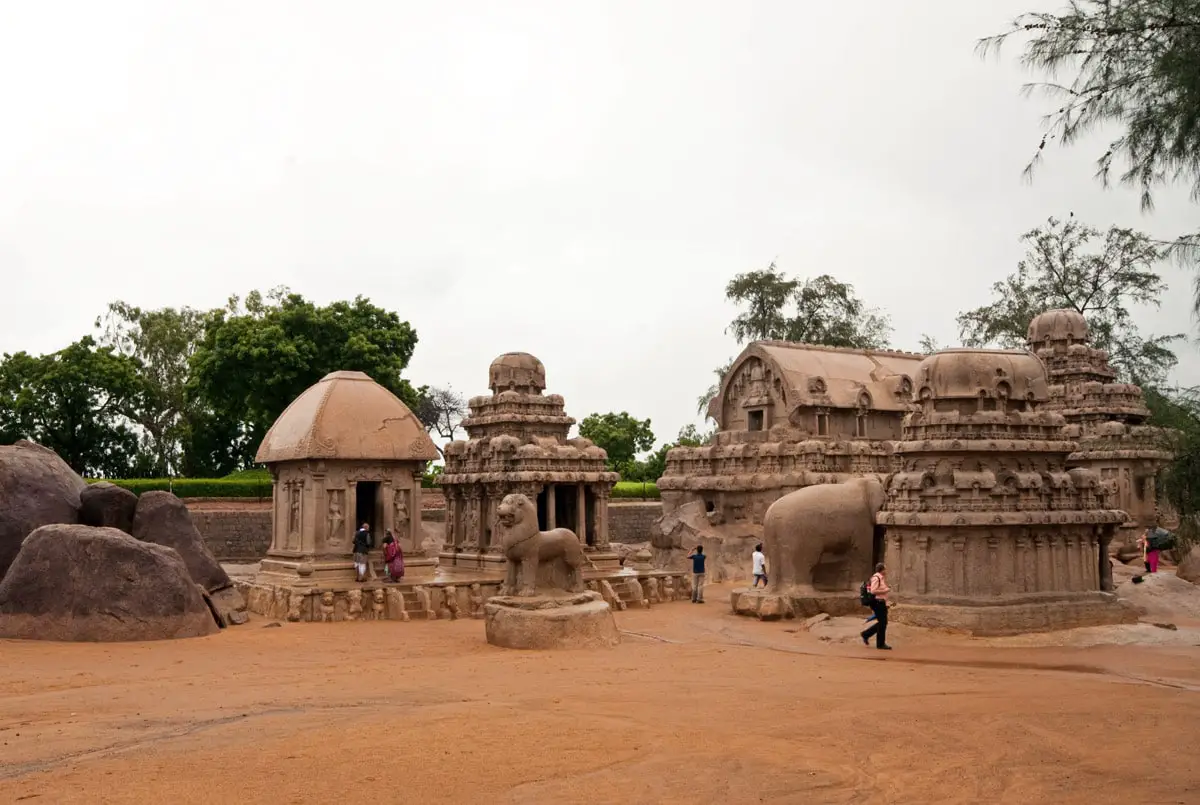
Bhima Ratha
The third shrine in a row is the longest of all rathas – it is 12.8 m long, 7.3 m wide, 7.6 m high. This is Gopura style temple with gabled roof.
Most likely this ratha was devoted to Anantshayi Vishnu.
The larger size of ratha can be explained by a large barelief of Vishnu in the form of Sayanamurti, which is located inside. It remains unfinished.
The sanctuary of this structure has a circumabulatory passage around it.
Pillars of the shrine are adorned with figures of lions.
Dharmaraja Ratha (Dharmaraja Yudhistar’s Ratha)
This ratha is shaped like a characteristic vimana (tower above the shrine) of Southern India of its times. This structure was abandoned before the completion but nevertheless it the most magnificent and tallest of all rathas, with three storeys.
The shrine is devoted to Shiva and is adorned with one of the best examples of early Pallava plastic art with important innovations in the art. Very beautiful are the Shiva figures on the corners of structure.
Dharmaraja Ratha contains an inscription in Pallava – Grantha script – it records the titles of Narasimhavarman I. Inscription mentions also that this was created as Shiva temple of Atyantakama Pallava.
Columns and pilasters of this ratha are adorned with lions.
The ground (first) floor of Dharmaraja Ratha is completed – it contains eight decorative panels.
Especially interesting and attractive is a panel, which shows Shiva reincarnation named Ardhanariswarar – half man, half women.
Small premises have been hewn in the other two floors of ratha as well. There are no stairs leading to the second floor, but the second and third floor are connected with stairs.

Animal statues
Among the rathas stand three large sculptures of animals – all carved out of monolithic stone. It is amazing tha all three statues are symbolically linked to certain rathas, thus complementing this unique ensemble of monolithic structures.
Statue of Nandi bull is not finished. This figurine is linked to Arjuna Ratha – shrine of Shiva.
Sculpture of lion is some 2 m high. It is located in the front of Draupadi Ratha – as it is normally placed in other temples which are devoted to Durga.
Elephant stands next to Nakula Sahadeva Ratha which is devoted to Indra – a deity owning the sacred white elephants.
Pancha Rathas of Mahabalipuram are included in the following article:
 Linked articles
Linked articles

Wonders of India
India is the seventh-largest country in the world by area, and, naturally, such a large area contains a huge amount of exciting attractions…
Wondermondo considers that India is the second richest center of architectural heritage in the world after Europe and maybe no single country in the world can match it in this respect.
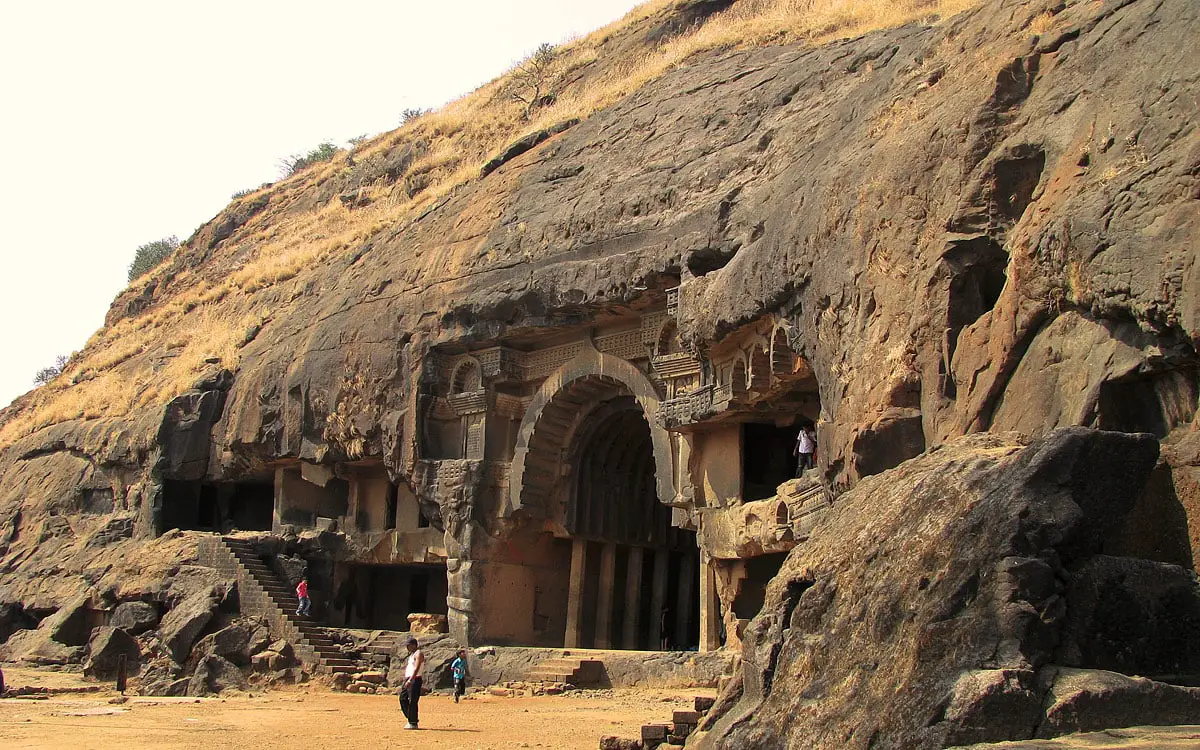
Rock-cut architecture and sculptures
Rock-cut architecture is a very ancient form of architecture – the oldest structures are more than 5 thousand years old. The resistivity of the natural stone and the constant climate inside these structures has preserved many art values around the world.
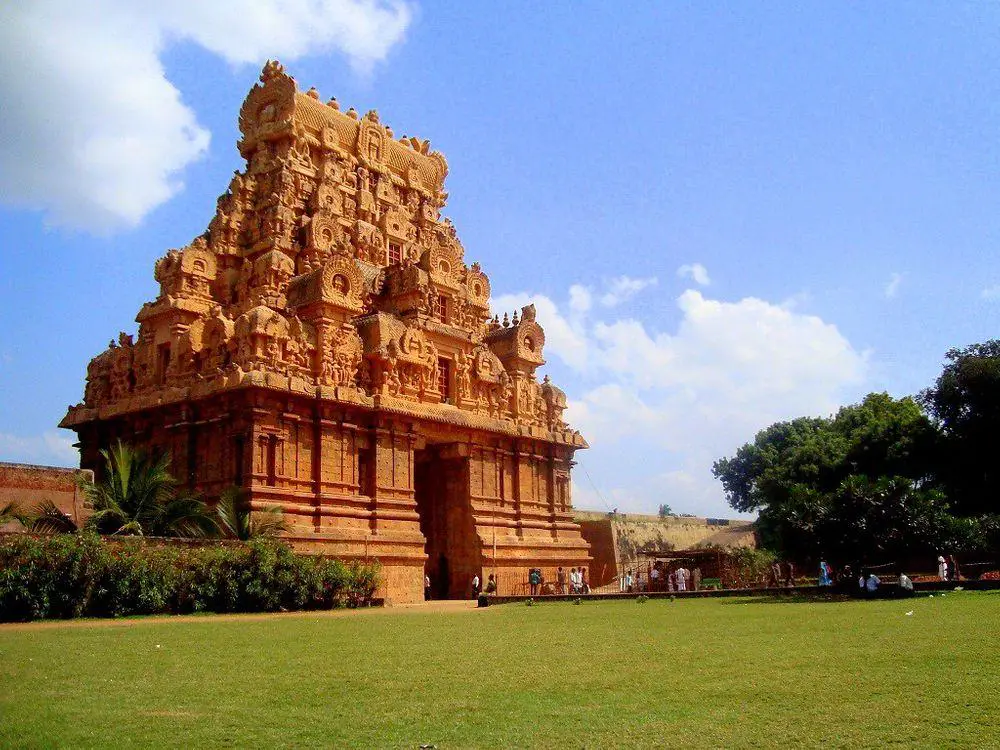
Hindu shrines
Hinduism is one of the oldest religions – possibly the oldest one among contemporary religions and Hindu temples belong to the most impressive religious buildings in the world.
 Recommended books
Recommended books
Tamil Nadu: The Heart of Dravidian India
The huge temples of Tamil Nadu are justifiably famous. Through history and forty-four original photographs, this book explains how the temples came to be and what their statuary symbolizes. The book also paints a picture of what life was like in the civilizations that built them.
Mahabalipuram (Monumental Legacy)
Constructed in 700 CE by the famous Pallava king Rajasimha, Mahabalipuram is a unique monument where art form combines with religion and legends. Also known as Mamallapuram, it showcases the best of Tamil art and architecture. The beauty of the monument is further enhanced by its location on the shores of the Bay of Bengal, the latter significantly influencing the creations. Part of the prestigious Monumental Legacy series, this book presents a graphic account of the site and its monuments-mandapas (cave temples), rathas (chariots), open-air bas-reliefs, and structural temples.

